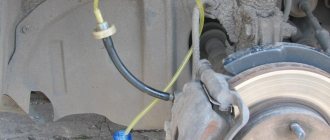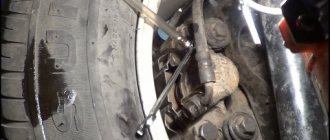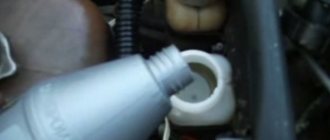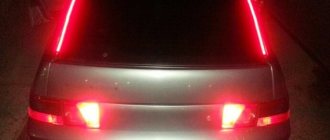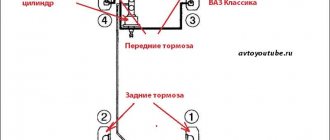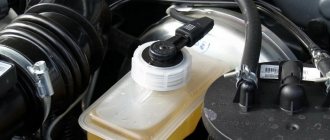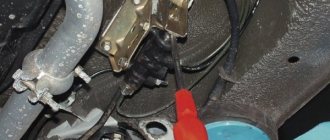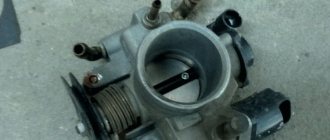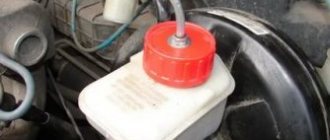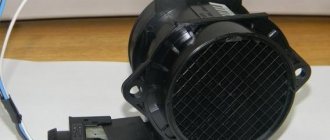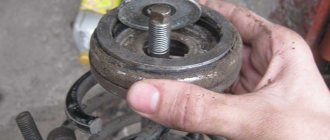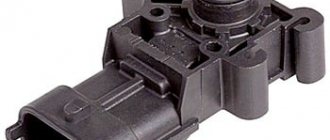The brake system in any car is the most important safety element. Despite the fact that it is one of the most reliable in the entire car design, it must be constantly maintained and repaired. In the VAZ 2114 model, the braking system is quite simple, so it can be repaired by the car owners themselves. Almost any procedure for replacing braking elements involves further pumping the brakes. Many people do not understand how to bleed the brakes on a VAZ 2114, so we will consider the procedure step by step.
Useful video:
Signs of air in the brake system
Airing the car's braking system is fraught with serious consequences, because... the next time you try to stop the car, the brake pedal may fail and not work. Diagnostics at every maintenance is a sure way to preserve the entire design. Most civilian vehicles are equipped with a hydraulic braking system from the factory. When the driver presses the pedal, force is transferred to the vacuum booster, which drives the calipers with pads. Due to this, braking occurs.
The situation when air enters this circuit manifests itself as follows:
- Increasing pedal free play;
- Too high “softness” and “cottonness” when pressed;
- Complete pedal failure.
Air ingress is caused by untimely maintenance of the machine. Infrequent replacement of pads leads to the fact that the calipers have to work for a complete fit, because The pads themselves are worn out. A lack of fluid in the circuit leads to early wear of the cylinders in the caliper and gradual leakage of air.
The lack of air in the circuit depends on how to properly bleed the brakes on a VAZ 2114. The procedure is not complicated, but it requires attention and double-checking, because The performance of all components must be normal.
Instructions for the last chapter in one video
Yes, as on most cars, bleeding is done crosswise, but I would advise changing the old brake hoses, pads and brake fluid for a brake system that does not fail. It’s better to spend money once and forget about the brakes than to constantly crawl under the car.
Pumping is not difficult, call an assistant and pump them according to the instructions in the manual. Just keep an eye on the brake fluid level when bleeding. After bleeding, drive off with caution. Until the pedal becomes hard and the pads are in place.
It often happens that for some reason one of the car’s wheels stops braking. Braking may occur either partially or not at all. Now we will look at some of the reasons.
You can easily understand that 1 wheel does not brake. You will be thrown to the side. This is dangerous when braking sharply; you may be thrown onto the side of the road or onto a bump stop.
1 phenomenon. The brake pedal is up, does not fall, the brakes do not get hot.
Reason 1. Oily pads. On the pads, as a result of grease getting on them, a layer can form that simply slides over the disc or drum; it should either be sanded off or the pads replaced.
Cause 2: Brake disc or brake drum. A situation may occur that the contact patch between the pad and the disc will be so small that the applied force is simply not enough for the wheel to start braking. In this case, you should pay attention to both the disc and the pads.
Drum brakes have the same system. To check, you can try to switch the drums in places; if the wheel starts to slow down, the conclusion is obvious.
Reason 3: Brake hose. Ask your partner to apply the brakes. There has been one case in my life when a brake hose swelled under pressure.
A lump formed on it and the pressure did not reach the cylinder.
2nd phenomenon. The pedal is up, the brakes are heating up.
Don’t go to a fortune teller here, you need to look for the problem in the brake cylinder or guides. If the guides move well or are missing, then the cylinder is most likely jammed.
Try to press it in first, if it doesn’t work, then press the brake pedal so that the cylinder comes out a little. Then press it in. Press the brake pedal again and press it again. This way you will develop a cylinder and it will last for some time. If it leaks, then it needs to be replaced.
3rd phenomenon. The brake pedal sinks and pumps up.
Most likely, somewhere the system has caught air or somewhere an air lock has not come out from the last pumping and you need to try bleeding the brakes. If that doesn't help, look for a place where brake fluid is leaking.
If the pedal starts to move while driving, you need to urgently stop and check for brake fluid leaks.
4th phenomenon. The pedal does not pump up from the word “at all”. Weak brakes at the very bottom. Brake fluid does not drain.
This is an internal malfunction of the brake master cylinder and you need to prepare to replace it. Since the fluid does not leave, there is no brake fluid leak, pressure is lost in the turbocharger, and the cuffs are leaking between the cylinders.
If when you press the brake pedal it fails, and after several presses everything returns to normal, it means there is air in the system. He needs to be kicked out, that is, pumped up. On the VAZ-2114 hatchback, you need to pump the brakes “diagonally”: start from the rear left wheel, move to the front right, etc. Also, if the rear axle is suspended, then install a screwdriver between the pressure regulator and the bracket.
We study the design of the brake system - watch the video.
Necessary tool
The pumping process should be carried out with a partner, because... It will be difficult to do the work yourself. To get results when working independently, you will need the following tools:
- A hose suitable for the fitting on the wheels of the car;
- Set of keys and sockets;
- Brake fluid;
- A rag for cleaning dirt from the caps;
- Container for liquid accumulation;
- Spare fittings in case the old ones break off.
It is also worth knowing the procedure for bleeding the brakes on a VAZ 2114, because... When performing the procedure, you should start with the rear wheels.
Preparation for work
First of all, disconnect the sensor connector and secure this connector next to the tank. Then open the lid and add liquid to the MAX mark. This requires DOT-4 fluid.
Level sensor connector
On any car, including the VAZ-2114, the brakes are pumped with the lid closed. This means we tighten the lid harder, and then roll the car onto an overpass or pit.
If a lift is used, it means that when bleeding the rear cylinders, a spline is placed in the regulator (sorcerer).
Pressure regulator (sorcerer)
The screwdriver here is between the bracket and the rod. When bleeding the front brakes, remove the screwdriver.
Safety precautions: the handbrake must be engaged and the ignition key must be removed.
Procedure for bleeding the brakes
Before starting the procedure, you should check all connections and hoses for leaks. If there are leaks and signs of friction, replace the hoses with new ones. Also keep in mind that the brake fluid you will fill must match what is already in the circuits. Starting from the rear wheel, the procedure is carried out diagonally. Only by following the procedure for bleeding the VAZ 2114 brakes will you get a good result.
For convenience, we present the sequence of pumping the brakes of a VAZ 2114:
- Rear left wheel.
- Front right wheel.
- Rear right.
- Front left.
If you have to bleed the brakes alone, study the video instructions for using a nipple from a tubeless wheel and an extended hose.
Replacing the TJ: reasons
If characteristic malfunctions occur, the brake fluid must be replaced. Let us describe the main points entailing the replacement of the TJ in the VAZ-2114:
- Leaks from brake cylinders leading to loss of fluid.
- The occurrence of air pockets in the pipeline and hoses. They appear due to broken tightness in the system.
- Deformation/scuffs of hoses removed from tires. The hoses also need to be replaced.
- Damage to the integrity of the sealing rings in the gas turbine engine, which leads to leakage of the fuel fluid.
- Leakage of working substance through the sealing ring of the pusher in the rear tires.
- Depressurization of the system circuit, which can be felt by a failed pedal.
- Mechanical failure of any part of the brake system. In addition to dismantling or installing new spare parts, you will need to replace the TJ.
Bleeding brakes on a VAZ 2114
Having decided in what order the brakes are pumped, you can begin. Note that it is convenient to pump in a pit. Step by step bleeding the brakes of a VAZ 2114 looks like this:
- Get to the rear wheel and find the bleeder fitting with a cap on the drum.
- Remove the protective cap and clean the surface from dirt.
- Next, put a hose of a suitable size on it, the other end of which leads into a container to collect the liquid.
- An assistant presses the brake pedal several times and leaves it pressed.
- Using a size 8 wrench, unscrew the fitting half a turn.
- The liquid from the fitting is drained until bubbles stop appearing. During the process, you need to add liquid to the tank and keep it at least at the minimum level.
- Next, go to the front wheel and carry out the same actions as described in paragraphs 3-6.
It is not recommended to carry out the work independently, without the help of a partner, because... To do this, the front wheels of the car will have to be hung. You will also have to find a way to supply pressure to the system.
Never add plain water to the tank. When frost sets in, the hoses will freeze and burst, making it impossible to stop the car. Carry a spare bottle of DOT4 fluid with you. If the reservoir level is low, add DOT4 to the correct level and locate the source of the leak.
Do not forget that at the moment when the air leaves the brake system, you must not allow the level in the reservoir to drop below the minimum. If this happens, the system will air again. To visually study the process, we recommend watching the video with step-by-step instructions.
Reasons for replacement
There are several characteristic malfunctions that must necessarily entail the replacement of the TJ.
- The presence of leaks from the brake cylinders, which lead to the loss of a large amount of fluid.
- The appearance of air pockets in the pipeline and hose system. They arise due to a leak in the brake system elements.
- Scuffs or deformation of flexible hoses installed on wheels. They also require replacement of the hoses themselves.
- Violation of the integrity of the sealing rings in the main brake cylinder, which leads to leakage of the working substance.
- Fluid leaking through the sealing ring of the pusher on the rear wheels.
- Violation of the tightness of the system circuit. This can be felt by a partially collapsed brake pedal.
- Mechanical failure of one of the elements of the braking system. In addition to repairing or replacing them, you will definitely have to change the TZ.
Choice of TZ
IMPORTANT! To ensure normal functionality of the braking system, the brake fluid must be selected correctly. Modern compositions such as "Rosa" consist of 93-98 percent polyglycols. The remaining percentages are additives that help combat oxidation and corrosion on the metal components of the vehicle.
To choose the best option for a brake substance, you should take into account the main parameters of its selection so that it meets the requirements of the VAZ 2114 model. After all, this is the car we are talking about.
| Index | Requirement |
| Boiling point | It must be high so that steam bubbles do not form inside the system and block the flow of liquid |
| Viscosity | Good viscosity ensures efficient pumping of fluid through the system |
| Hygroscopicity | This criterion is responsible for the ability of a substance to absorb water |
| Lubrication | The thermal fluid should not only promote braking, but also prevent overheating of the internal surfaces due to the lubricating effect |
| Neutral to rubber | The composition should not have a destructive effect on the rubber elements used in the system |
| Corrosion resistance | The liquid should protect metal elements from corrosion and rust. |
| TZh class | You should choose the DOT 3 marking |
Having chosen the vehicle that is suitable for your car, you should replace it. It’s entirely possible to do the work yourself, but you should first read the instruction manual, consult with specialists, or watch visual video lessons.
Where does the air in the brakes come from?
Untimely maintenance and inattention to the technical condition of the machine are not all the reasons why air problems occur. Let's consider several main reasons for the violation of the tightness of all circuits:
- Replacing technical fluid throughout the entire circuit involves draining the old DOT4. At the moment of refilling, air also enters the circuit;
- There are hoses going to the brake cylinder, damage to which is a very common situation on VAZ. Over time, they begin to “sweat” and become airy;
- Cylinder leaks (both rear and front);
- Leak from the GTZ.
Timely maintenance involves replacing all fluids in the car, incl. and brake. Ignoring this fact plays a cruel joke on drivers. With long runs, moisture somehow gets into the system, which reduces the resistance of DOT4 to low temperatures. In cold weather, the pipes can crack and render the machine stopping unit unusable. Also, do not allow DOT4 to come into contact with paint surfaces. It contains quite aggressive elements that can damage the paint. If you carry out manipulations yourself, using a compressor to pump up pressure, follow the safety rules. Excessive pressure will cause the pipes to rupture and spill their contents onto you. After completing the work, do not rush to accelerate and check the effectiveness of the brakes at high speed. It is enough to press the pedal several times and feel how much it sinks. In a situation where following the instructions does not produce results, contact the service specialists. It is better to pay for brake system repairs with money than with your safety.
Design
The task of the driver and car owner part-time is to constantly monitor the condition of the brake system.
Failure of one of its elements can lead to serious consequences. Therefore, you should know what exactly is included in the braking system.
The components of the vehicle are:
- Brake fluid reservoir mounted on the GTZ;
- Metal pipelines of two circuits;
- Flexible brake hoses for front and rear wheels;
- GTZ (brake master cylinder located in the engine compartment);
- Brake cylinders of front and rear wheels;
- Pressure regulator;
- Brake fluid level sensor;
- Vacuum booster.
Tank with TJ
According to the recommendations of specialists, the replacement of the TZ is carried out once every 3 years, but at least once every 45 thousand kilometers.
When is pumping required and how to prepare for it
Bleeding the brakes is not always necessary - if the brake system is functioning properly, then bleeding is not necessary.
It is required only in the following three situations:
- When the pedal begins to “fail” (as was mentioned at the very beginning of the article).
- After replacing any component of the brake system.
- After replacing the fluid.
All these situations are caused by one single reason - air entering the system. So, if the pedal began to “fall” by itself, then, most likely, the brake tract was depressurized in some area, and air leaked inside.
When replacing parts, air also enters the brake system in large quantities and remains inside, causing its failure (the same applies to a complete replacement of the brake fluid).
Preparation for work
First of all, disconnect the sensor connector and secure this connector next to the tank. Then open the lid and add liquid to the MAX mark. This requires DOT-4 fluid.
Level sensor connector
On any car, including the VAZ-2114, the brakes are pumped with the lid closed. This means we tighten the lid harder, and then roll the car onto an overpass or pit.
If a lift is used, it means that when bleeding the rear cylinders, a spline is placed in the regulator (sorcerer).
Pressure regulator (sorcerer)
The screwdriver here is between the bracket and the rod. When bleeding the front brakes, remove the screwdriver.
Safety precautions: the handbrake must be engaged and the ignition key must be removed.
Why does the brake pedal fail when braking and what to do?
Is your car suddenly having problems with its brakes? There is no need to panic. There are special techniques that will help you gradually slow down and stop the car even in this case. The most useful tool in this case is the parking brake, or “handbrake”.
It can slow down and stop the car if it was traveling at a speed of 20–40 km/h. But if you have little driving experience, there is no need to suddenly raise the handbrake at medium and high speeds, especially when driving on a wet, icy or snowy road. Your car may skid, spin, be thrown off the road, into the oncoming lane, etc.
Possible malfunctions of the regulator
In general, there are few malfunctions that can occur in the sorcerer. These include:
- Valve jamming;
- Misalignment of position;
- Brake fluid leaks.
A deregulated sorcerer can be adjusted. You can determine the need for adjustment by the behavior of the car when you press the brake. If the regulator is set incorrectly, the car starts to toss to the side.
If the valve jams or fluid leaks, the mechanism must be replaced. Theoretically, it can be repaired. However, the process of such repairs is complex and expensive, which makes it unprofitable.
Instructions for the last chapter in one video
Yes, as on most cars, bleeding is done crosswise, but I would advise changing the old brake hoses, pads and brake fluid for a brake system that does not fail. It’s better to spend money once and forget about the brakes than to constantly crawl under the car.
Pumping is not difficult, call an assistant and pump them according to the instructions in the manual. Just keep an eye on the brake fluid level when bleeding. After bleeding, drive off with caution. Until the pedal becomes hard and the pads are in place.
Examination
The operation of the VAZ-2109, 2110 and other AvtoVAZ models is checked on the move, in closed areas. To do this, accelerate the car to a speed of 40 km/h and sharply press the brake. The rear wheels should lock 1/2 second later than the front wheels.
The wheels are monitored by an assistant located outside the car. If wheel locking occurs noticeably later or does not occur at all, and also if the rear axle is locked simultaneously with the front, the sorcerer adjustment procedure is repeated.
To increase the response time of the rear brakes, the gap between the adjuster and the bracket is increased; to shorten it, it is reduced accordingly.
Source
